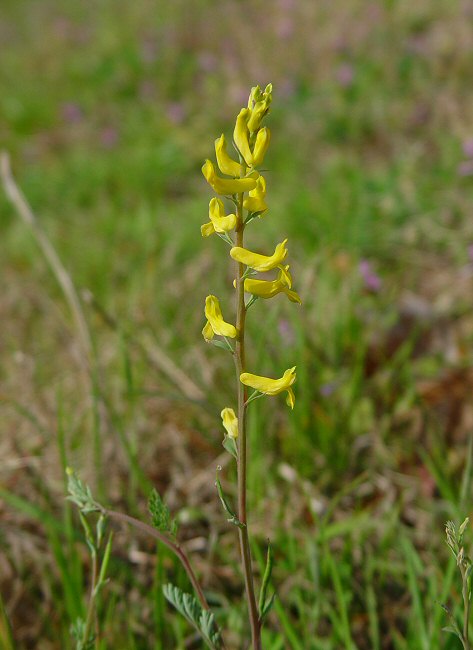Corydalis micrantha ssp. australis (Chapm.) G.B. Ownbey
Small-Flowered Corydalis

Native
CC = 10
CW = 5
MOC = 6
SRank = S2
© DETenaglia
Corydalis micrantha ssp. australis (Chapm.) G.B. OwnbeySmall-Flowered Corydalis | |
 |
Native CC = 10 CW = 5 MOC = 6 SRank = S2 |
© DETenaglia |
|
Family - Fumariaceae Habit - Taprooted annual or biennial forb. Plants green or more commonly gray and glaucous. Stems - Loosely to strongly ascending, to 35 cm, often from a spreading base.
Leaves - Basal and alternate, 2-3 times compound or lobed. Basal and lower stem leaves with the petiole 2-6 cm long, the upper leaves mostly sessile. Leaf blades 1-7 cm long, with mostly 5 or 7 pinnae, these deeply several-lobed, the ultimate segments linear or narrowly to broadly oblong-elliptic, lanceolate, or occasionally obovate.
Inflorescences - Usually extending well past the foliage (except in those with mostly cleistogamous flowers), those with open flowers racemes with 5-20-flowers, those with cleistogamous flowers clusters or short racemes with 1-6-flowers. Flower stalks 2-6 mm long, ascending at flowering and fruiting. Flowers - Corollas pale yellow to yellow, the upper outer petal 11-14 mm long, the spur 4-6 mm long, straight or nearly so, blunt and not expanded at the tip, the concave apical portion with a low, irregular crest or occasionally merely keeled.
Fruits - Capsules 15-25 mm long, straight or curved, glabrous, not appearing mealy. Seeds 1.4-1.6 mm long, the surface minutely pebbled (best observed with magnification), the rounded rim lacking a marginal ridge.
Flowering - April - June. Habitat - Sand prairies, dry upland forests openings, ditches, crop fields, railroads, roadsides, and disturbed sandy areas. Origin - Native to U.S. Lookalikes - Other species of Corydalis. Other info. - This species can be found mainly in the western half of Missouri. The plant can be identified by its erect fruits, silvery-green leaves, and the straight spur of its flower. Many species of Corydalis resemble each other and slight differences in the fruits and flowers are used to distinguish them. The photos above represent the less common of the two subspecies found in Missouri, ssp. australis. This form is characterized by inflorescences rising well above the foliage and relatively slender fruits up to 3 cm in length. It has a strong preference for sandy soils. Photographs taken off Hwy 29, Pike County, AL., 2-26-05 (DETenaglia). |